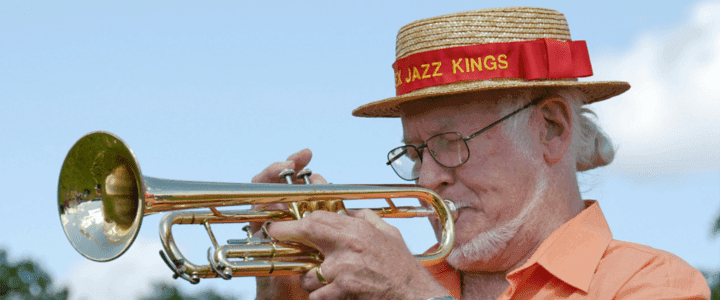 Jazz is an exciting and rewarding genre for all types of musicians to study and play. If you’ve developed proficiency on your instrument, you might be interested in starting a jazz band. One of the beautiful things about playing jazz is that it can be performed with any number or combination of instruments, from a solo pianist all the way up to a full orchestra! Most “traditional” jazz ensembles usually consist of a harmonic element (like piano or guitar), bass (which can fall under both harmonic and rhythmic), and a rhythmic element (drums or percussion). Many groups also add a melodic instrument like saxophone or trumpet. Let’s look at the function these jazz band instruments play in a jazz ensemble, and also some additional instruments and combos that can make jazz a rich, intense, and expressive musical style.
Jazz is an exciting and rewarding genre for all types of musicians to study and play. If you’ve developed proficiency on your instrument, you might be interested in starting a jazz band. One of the beautiful things about playing jazz is that it can be performed with any number or combination of instruments, from a solo pianist all the way up to a full orchestra! Most “traditional” jazz ensembles usually consist of a harmonic element (like piano or guitar), bass (which can fall under both harmonic and rhythmic), and a rhythmic element (drums or percussion). Many groups also add a melodic instrument like saxophone or trumpet. Let’s look at the function these jazz band instruments play in a jazz ensemble, and also some additional instruments and combos that can make jazz a rich, intense, and expressive musical style.
Jazz Duos Trios and Quartets
There are many interesting and diverse combinations of jazz band instruments. Makoto Ozone and Gary Burton have been creating and performing jazz duets for two decades on piano and vibraphone. Other musicians such as Bhob Rainey and Greg Kelley have been pushing the jazz envelope with their duet called nmperign. Rainey plays soprano sax and Kelley is an amazing trumpet virtuoso. Together they play free improvisational jazz that can range from stark and sparse to frenetic and dense.
A duet can be almost any combination of instruments. Piano and sax, organ and vocals, or even trumpet and sax are all great combos for jazz.
The trio is a more “traditional” arrangement for jazz. It usually consists of piano or guitar along with bass and drums. This combination is strong and gives harmonic and melodic expression through the piano or guitar along with a solid foundation and rhythm from the bass and drums. This type of ensemble is going to sound more recognizable to the listener and can perform a wide range of music from jazz standards to arrangements of pop or rock tunes done in the jazz style. Check out the Brad Mehldau Trio for some amazing jazz arrangements of pop tunes.
The classic jazz group is the quartet. Add a horn to the traditional jazz trio and you have a whole new sound. With the quartet grouping you add an element of melodic harmony to the sound. Adding a melodic instrument like the sax or trumpet can create interesting counterpoint elements. Check out John Coltrane’s classic quartet as an amazing example of this kind of grouping.
Quintets and Beyond
Taking the classic quartet to the next level means adding a second horn player to complement the first. If a sax player fronts your quartet, for example, add a trumpet. The extra horn allows for a wider range of harmony and depth. Miles Davis had a series of amazing quintets throughout the ’50s and ’60s that changed the face of jazz music and launched the careers of John Coltrane and Wayne Shorter, who both went on to front their own combos.
Beyond the quintet, the sky is the limit. Bigger groups allow for more stunning composition, richer harmonies, and an expanded timbre pallet for the music. Many musicians have written and performed with larger ensembles, including Charles Mingus and John Coltrane. Additional jazz band instruments you can add to fill out the sound include trombone, baritone sax, percussion, electronic keyboards, or even strings, like violin or cello. You are only limited by the availability of musicians and your ability to arrange music for a larger ensemble.
During the 1930s through the late 1970s, the jazz big band was king. The typical big band consisted of a rhythm section of piano, bass, drums, and guitar, along with five saxophones (two altos, two tenors, and a baritone that commonly doubled on flute and clarinet), five trumpets, and four trombones. Big bands are still popular today, such as New York’s Mingus Big Band.
Getting Started
If you are interested in starting a jazz combo, the best advice is to start small. Find other musicians who play typical jazz band instruments. If you play piano, find a horn player you like working with and start by developing a duo repertoire. Once you’re comfortable playing together, add a bass player and drummer and grow into a quartet. Maybe add a second horn player to expand your musical palette. You are only limited by your creativity! There are any number of non-traditional combos out there that perform and record amazing jazz music. The most important step to take is the first one; put together your band and get to work!
Photo by Chris_Parfitt
Shanika

